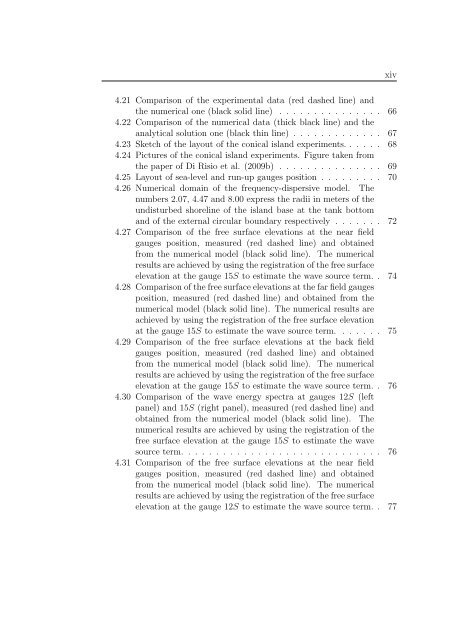Numerical modeling of waves for a tsunami early warning system
Numerical modeling of waves for a tsunami early warning system
Numerical modeling of waves for a tsunami early warning system
You also want an ePaper? Increase the reach of your titles
YUMPU automatically turns print PDFs into web optimized ePapers that Google loves.
xiv<br />
4.21 Comparison <strong>of</strong> the experimental data (red dashed line) and<br />
the numerical one (black solid line) . . . . . . . . . . . . . . . 66<br />
4.22 Comparison <strong>of</strong> the numerical data (thick black line) and the<br />
analytical solution one (black thin line) . . . . . . . . . . . . . 67<br />
4.23 Sketch <strong>of</strong> the layout <strong>of</strong> the conical island experiments. . . . . . 68<br />
4.24 Pictures <strong>of</strong> the conical island experiments. Figure taken from<br />
the paper <strong>of</strong> Di Risio et al. (2009b) . . . . . . . . . . . . . . . 69<br />
4.25 Layout <strong>of</strong> sea-level and run-up gauges position . . . . . . . . . 70<br />
4.26 <strong>Numerical</strong> domain <strong>of</strong> the frequency-dispersive model. The<br />
numbers 2.07, 4.47 and 8.00 express the radii in meters <strong>of</strong> the<br />
undisturbed shoreline <strong>of</strong> the island base at the tank bottom<br />
and <strong>of</strong> the external circular boundary respectively . . . . . . . 72<br />
4.27 Comparison <strong>of</strong> the free surface elevations at the near field<br />
gauges position, measured (red dashed line) and obtained<br />
from the numerical model (black solid line). The numerical<br />
results are achieved by using the registration <strong>of</strong> the free surface<br />
elevation at the gauge 15S to estimate the wave source term. . 74<br />
4.28 Comparison <strong>of</strong> the free surface elevations at the far field gauges<br />
position, measured (red dashed line) and obtained from the<br />
numerical model (black solid line). The numerical results are<br />
achieved by using the registration <strong>of</strong> the free surface elevation<br />
at the gauge 15S to estimate the wave source term. . . . . . . 75<br />
4.29 Comparison <strong>of</strong> the free surface elevations at the back field<br />
gauges position, measured (red dashed line) and obtained<br />
from the numerical model (black solid line). The numerical<br />
results are achieved by using the registration <strong>of</strong> the free surface<br />
elevation at the gauge 15S to estimate the wave source term. . 76<br />
4.30 Comparison <strong>of</strong> the wave energy spectra at gauges 12S (left<br />
panel) and 15S (right panel), measured (red dashed line) and<br />
obtained from the numerical model (black solid line). The<br />
numerical results are achieved by using the registration <strong>of</strong> the<br />
free surface elevation at the gauge 15S to estimate the wave<br />
source term. . . . . . . . . . . . . . . . . . . . . . . . . . . . . 76<br />
4.31 Comparison <strong>of</strong> the free surface elevations at the near field<br />
gauges position, measured (red dashed line) and obtained<br />
from the numerical model (black solid line). The numerical<br />
results are achieved by using the registration <strong>of</strong> the free surface<br />
elevation at the gauge 12S to estimate the wave source term. . 77

















